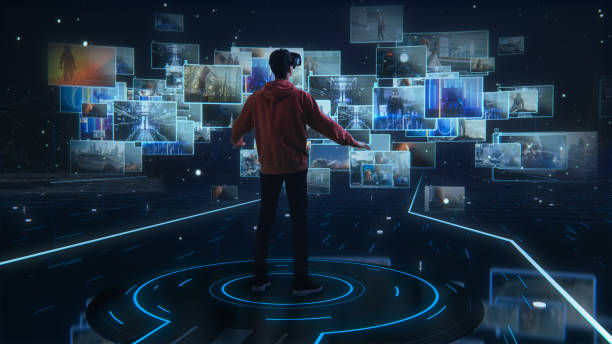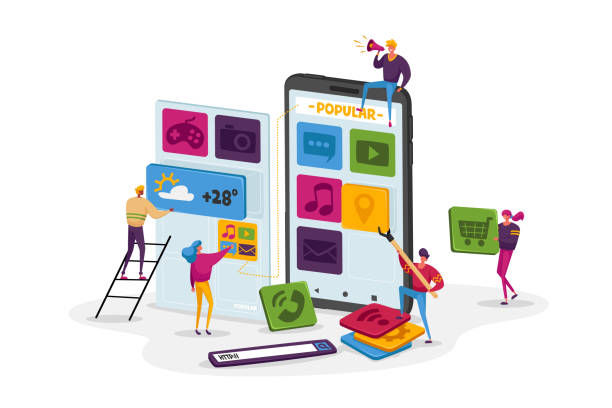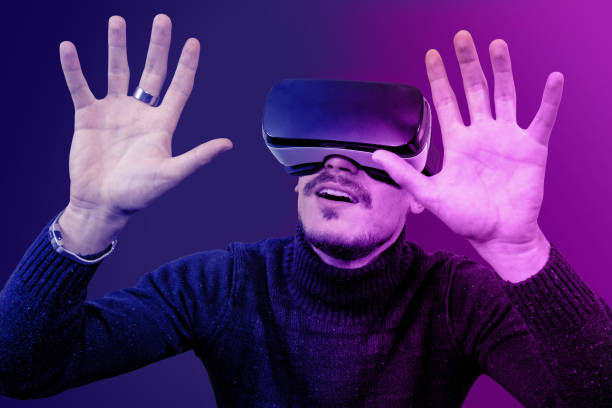Virtual Reality and Social Interaction: Navigating the Social Implications of an Immersive World.
- The Moolah Team
- Jul 10, 2023
- 10 min read
This post will examine the social implications of VR, including the potential for VR to enhance social interaction and collaboration, as well as the potential risks of isolation, addiction, and over-dependence on immersive technology.
I. Introduction: Exploring the Social Implications of Virtual Reality
Virtual Reality (VR) has rapidly emerged as a transformative technology that is rapidly changing the way we interact with the world around us. Unlike other forms of technology that are limited to visual and auditory interfaces, VR immerses users into a fully-realized digital world that can be manipulated, explored, and experienced in ways that were once impossible. With the rise of VR, there is a growing need to understand the social implications of this new technology, particularly when it comes to social interaction.
VR technology has been in development since the 1960s, but it wasn't until recently that it has become accessible and affordable for the average person. With the rise of VR headsets, like the Oculus Quest and HTC Vive, the technology has become more widely available and affordable, which has led to a surge in popularity. As a result, VR is being used for a wide variety of applications, from gaming and entertainment to education and healthcare.
However, as with any new technology, there are both benefits and risks associated with VR, particularly when it comes to social interaction. On one hand, VR has the potential to enhance social interaction by providing immersive and engaging experiences that bring people together. On the other hand, there are risks associated with over-reliance on VR that could lead to isolation, addiction, and negative effects on mental and physical health.
Given the growing popularity of VR and the potential impact it could have on social interaction, it is essential that we explore the social implications of this technology in-depth. By doing so, we can better understand how to harness the benefits of VR for social interaction while minimizing the risks associated with its use.
In this blog post, we will explore the social implications of VR, including the potential for VR to enhance social interaction and collaboration, as well as the potential risks of isolation, addiction, and over-dependence on immersive technology. We will also discuss strategies for addressing these risks and promoting responsible use of VR for social interaction.

II. Benefits of VR for Social Interaction
Virtual Reality has the potential to revolutionize social interaction by providing immersive and engaging experiences that can bring people together.
Here are some of the key benefits of VR for social interaction:
A. Immersive and Engaging Experiences
VR offers a level of immersion and engagement that is difficult to achieve through other forms of technology. By placing users in a fully-realized digital world, VR can create a sense of presence and participation that is unparalleled. This can be particularly useful for social interaction, as it can create a shared experience that brings people together. For example, VR can be used to create virtual social events, such as concerts, parties, or gatherings, that allow people to interact with each other in a way that feels real and meaningful.
B. Enhanced Collaboration and Teamwork
VR can also enhance collaboration and teamwork by providing a shared digital space where people can work together on projects or tasks. For example, VR can be used in educational settings to create virtual classrooms where students can collaborate on projects or participate in group discussions. Similarly, VR can be used in the workplace to facilitate remote collaboration between team members who are in different locations.
C. Access to New Social Opportunities
VR can provide access to new social opportunities that might not be available in the real world. For example, VR can be used to connect people from around the world who share common interests or hobbies. This can be particularly beneficial for people who might be socially isolated due to factors such as geography, disability, or social anxiety.
D. Increased Empathy and Understanding
VR can also increase empathy and understanding by allowing people to experience situations from different perspectives. For example, VR can be used to create simulations that simulate the experience of living with a disability or being in a different cultural context. By providing these experiences, VR can promote empathy and understanding, which can in turn enhance social interaction.
Overall, VR has the potential to enhance social interaction by providing immersive and engaging experiences, enhancing collaboration and teamwork, providing access to new social opportunities, and increasing empathy and understanding. However, it is important to balance these benefits with the potential risks associated with over-reliance on VR. In the next section, we will explore some of these risks and how to address them.

III. Risks of VR for Social Interaction
While VR has the potential to enhance social interaction, it also poses some potential risks that need to be considered.
Here are some of the key risks of VR for social interaction:
A. Isolation and Lack of Physical Interaction
One of the most significant risks of VR for social interaction is the potential for isolation and lack of physical interaction. While VR can create immersive and engaging digital worlds, it can also separate people from the real world and limit their opportunities for physical social interaction. This can lead to feelings of loneliness and disconnection, and can have negative effects on mental health and wellbeing.
B. Addiction and Over-Reliance
Another risk of VR for social interaction is the potential for addiction and over-reliance. VR can be incredibly engaging and immersive, and some people may become addicted to the experience of being in a virtual world. This can lead to over-reliance on VR for social interaction, and can have negative effects on real-world relationships and social skills.
C. Digital Surveillance and Privacy Concerns
VR also poses digital surveillance and privacy concerns that need to be considered. In order to create immersive digital worlds, VR companies collect large amounts of personal data about their users, including their movements, actions, and interactions. This data can be used for a range of purposes, including targeted advertising, and can pose a risk to users' privacy.
D. Accessibility and Equity
Finally, VR poses potential accessibility and equity concerns. While VR can provide new social opportunities for many people, it may also be inaccessible to others due to factors such as cost, disability, or lack of technical expertise. This can create social inequalities and limit the potential benefits of VR for social interaction.
Overall, while VR has the potential to enhance social interaction, it is important to consider the potential risks associated with over-reliance on immersive technology. By balancing the benefits and risks of VR, we can create a more inclusive and equitable digital world that enhances, rather than replaces, real-world social interaction.

IV. Potential Benefits of VR for Social Interaction
While VR poses some potential risks, it also offers a range of potential benefits for social interaction.
Here are some of the key benefits of VR for social interaction:
A. Enhanced Collaboration and Communication
One of the primary benefits of VR for social interaction is the potential for enhanced collaboration and communication. VR can enable people to work together in immersive digital environments, regardless of their physical location. This can be particularly valuable for remote teams or those working on complex projects that require close collaboration.
B. Increased Empathy and Understanding
VR can also increase empathy and understanding between people. By immersing users in different environments and perspectives, VR can provide a deeper understanding of other people's experiences and foster greater empathy and understanding. This can be particularly valuable for promoting diversity and inclusion in the workplace and other social settings.
C. Access to New Social Opportunities
VR can provide access to new social opportunities that may not be available in the real world. For example, people with physical disabilities or social anxiety may find it easier to socialize in virtual worlds, where they can interact with others without the same physical barriers or social pressures.
D. Improved Education and Training
VR can also enhance education and training by providing immersive and interactive learning experiences. By simulating real-world scenarios, VR can provide students with practical skills and experience that may be difficult to replicate in traditional classroom settings. This can be particularly valuable for fields such as medicine or engineering, where practical experience is critical.
E. New Forms of Entertainment
Finally, VR offers new forms of entertainment that can bring people together and enhance social interaction. VR gaming, for example, can provide immersive and engaging experiences that can be shared with friends and family.
Overall, while VR poses potential risks for social interaction, it also offers a range of potential benefits that can enhance collaboration, communication, empathy, and understanding. By leveraging the potential of VR for social interaction, we can create a more inclusive and equitable digital world that enhances real-world social connections.

V. Potential Risks of VR for Social Interaction
While VR offers a range of potential benefits for social interaction, it also poses some potential risks.
Here are some of the key risks of VR for social interaction:
A. Isolation and Social Withdrawal
One of the primary risks of VR for social interaction is the potential for isolation and social withdrawal. Spending too much time in immersive digital environments can lead to a lack of real-world social connections and an over-reliance on virtual interactions. This can have negative impacts on mental health and well-being, as well as on overall social development.
B. Addiction and Over-Reliance
Another risk of VR for social interaction is addiction and over-reliance on immersive technology. Like other forms of digital media, VR can be highly engaging and addictive, leading to compulsive use and a lack of control over usage patterns. This can have negative impacts on productivity, mental health, and overall well-being.
C. Privacy and Security Concerns
VR also poses potential privacy and security concerns for social interaction. Immersive digital environments can capture and store a range of personal data, including biometric information and behavioural data. This data could be vulnerable to breaches or misuse, potentially putting users at risk.
D. Disinhibition and Online Harassment
VR can also lead to disinhibition and online harassment. Anonymity and distance can make it easier for users to engage in negative behaviours such as cyberbullying or trolling, potentially leading to harm or trauma for individuals or communities.
E. Social Exclusion and Inequality
Finally, VR can contribute to social exclusion and inequality. While virtual environments may provide access to new social opportunities, they may also exclude certain groups or reinforce existing social hierarchies. For example, individuals without access to VR technology or with limited digital literacy may be left behind, contributing to further inequality.
Overall, while VR offers many potential benefits for social interaction, it is important to be aware of the potential risks and to take steps to mitigate them. By promoting responsible and ethical use of VR, we can create a more equitable and inclusive digital world that enhances real-world social connections.

VI. The Future of VR and Social Interaction
As VR technology continues to develop and become more accessible, it is likely to play an increasingly important role in social interaction.
Here are some potential future developments in this space:
A. Increased Access and Affordability
One major trend in the development of VR is increased access and affordability. As the technology becomes more widespread and production costs decrease, more people are likely to have access to immersive digital environments. This could lead to new social opportunities and increased social connectivity.
B. Improved Realism and Immersion
Another trend in VR development is improved realism and immersion. As the technology continues to evolve, virtual environments may become even more realistic and immersive, providing users with a more authentic and engaging social experience.
C. Integration with Other Technologies
VR is also likely to become increasingly integrated with other technologies, such as artificial intelligence, social media, and gaming platforms. This could lead to new forms of social interaction and collaboration, as well as new risks and challenges.
D. Advancements in Haptic Feedback
Haptic feedback, which allows users to feel and interact with virtual objects and environments, is also a key area of development in VR. As this technology continues to advance, users may be able to experience even more realistic and tactile social interactions in virtual environments.
E. Continued Ethical and Social Considerations
As VR technology evolves, it will be important to continue to address ethical and social considerations related to its use. This may include issues related to privacy, security, accessibility, and equality. By proactively addressing these issues, we can ensure that VR technology is developed in a way that supports positive social outcomes.
Overall, the future of VR and social interaction is likely to be shaped by a range of technological, social, and ethical factors. By staying informed about these trends and engaging in responsible and ethical use of VR technology, we can create a more connected and inclusive digital world.

VII. Risks and Challenges of VR and Social Interaction
While there are many potential benefits to using VR for social interaction, there are also several risks and challenges that must be considered. Here are some of the key concerns:
A. Isolation and Addiction
One potential risk of using VR for social interaction is that it could lead to increased isolation and addiction. While virtual environments can provide a sense of social connection, they can also be isolating if they replace real-world social interaction. Additionally, some users may become addicted to the immersive experiences provided by VR, leading to negative social and psychological outcomes.
B. Over-Dependence on Technology
Another challenge of using VR for social interaction is the risk of over-dependence on technology. If users rely too heavily on virtual environments for social interaction, they may lose important social skills and become less able to navigate real-world social situations. This could have negative impacts on mental health and overall social well-being.
C. Ethical Considerations
There are also ethical considerations related to the use of VR for social interaction. For example, virtual environments may allow users to engage in behaviors that would be considered unacceptable in the real world, such as harassment or bullying. It is important to ensure that these environments are designed in a way that promotes positive social interactions and does not perpetuate harmful behaviours.
D. Accessibility
Another challenge of using VR for social interaction is accessibility. While VR technology has the potential to provide new social opportunities for people with disabilities, it is important to ensure that these environments are designed in a way that is accessible to everyone. This may require additional development and investment in accessibility features and tools.
E. Safety Concerns
Finally, there are safety concerns associated with the use of VR technology. For example, users may be at risk of injury if they are not careful when navigating virtual environments. Additionally, there are concerns related to privacy and data security, as well as the potential for cyberbullying and other forms of online harassment.
Overall, it is important to approach the use of VR for social interaction with a thoughtful and critical mindset. By being aware of the potential risks and challenges associated with this technology, we can work to ensure that it is developed and used in a way that supports positive social outcomes and avoids negative impacts on mental health and overall social well-being.

VIII. Conclusion: Navigating the Social Implications of an Immersive World
The emergence of virtual reality technology presents exciting opportunities for enhancing social interaction and collaboration. With the ability to simulate realistic social environments, VR has the potential to bring people closer together despite physical distance or limitations. However, as with any new technology, there are also potential risks and challenges to consider.
It is important for individuals, as well as developers and policymakers, to navigate these social implications in a responsible and thoughtful manner. This includes considering the potential for isolation and addiction, as well as the need to promote diversity and inclusivity within VR communities.
As VR technology continues to advance and become more accessible, it is important to have ongoing conversations and research about the social implications and how to address any negative consequences that may arise. Ultimately, by embracing the potential benefits while being mindful of the risks, we can use VR technology to enhance social interaction and create a more connected and inclusive world.
Thank you for taking the time to read this post on virtual reality and social interaction. We hope that it has provided valuable insights into the potential benefits and risks of this emerging technology. As VR continues to shape our world, it is important to approach it with caution and consideration, while also embracing the possibilities for enhanced social interaction and collaboration. Don't forget to subscribe to our newsletter for more updates and insights. Thanks a million for your support!
Best regards,
Moolah







Comments